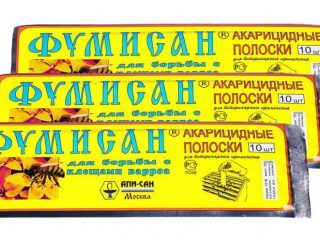Content
Dilabik for bees, the instructions for use of which should be carefully read, is a medicine. A must have in the arsenal of every beekeeper who wants to see their furry pets healthy and viable. The main enemy of bees is the mite, which can be gotten rid of using folk remedies and medications. The most effective drug is Dilabik.
Application in beekeeping
Dilabic for bees is a medicinal drug used for preventive measures and the fight against varroatosis. To determine the disease, it is necessary to carefully examine the bees. When a mite is infested, small dark brown plaques can be seen on the abdomen, cephalothorax of adult bees and on the body of pupae.
Composition, release form
Dilabik for bees is produced in a package of 10 ampoules with a volume of 0.5 ml.
The composition of 0.5 ml of the drug Dilabik includes 2 types of highly purified amitraz, which, when used regularly, prevent the tick from getting used to this drug. When treating frames by watering, the drug Dilabik is completely consumed by bees, without causing side effects and without being deposited in beekeeping products.
Pharmacological properties
Dilabik for bees is a Russian substance of 2 isomers of amitraz. Based on the content of additional components, the medicine belongs to the 4th toxicity group, which meets the standard for its use and contact with beekeeping products.
Dilabik: instructions for use
According to beekeepers, Dilabik is effective for combating varroa and for carrying out preventive measures. For safety reasons, beehives are processed using gloves and a respirator. It is not recommended to smoke, eat or drink while working. After finishing the treatment, wash your hands and face with hot water and soap.
Dosage, rules of use
According to the instructions, Dilabik is used in autumn and spring. Directions for use:
- In the fall, the hive is treated 2 times: immediately after pumping out the honey and preparing the bee colony for winter, the second time during the formation of the bee club, at an air temperature of + 3-10 ° C. Half an hour before the start of treatment, prepare the solution. To do this, dip an ampoule of concentrate into 1 liter of warm boiled water and gently crush it.
- The solution is thoroughly mixed and drawn into a 10 cc syringe. The medicine is poured into the space between the frames, using 10 ml for each street. Since the drug has a long-lasting effect, in the spring it will be enough to use 10 ml of a solution prepared in a similar way for each frame.
- The drug Dilabik can be used by fine spraying through an aerosol spray. To do this, dissolve the ampoule in 1 liter of boiled water and treat the frames on both sides with 5 ml.
- You can use a smoke cannon. To do this, dissolve 8 ampoules of 0.5 ml in half a glass of warm water. Each family consumes 2-3 ml of the finished medicine. It is served as a thin stream of steam through the bottom tray. Treatment with a smoke gun is done 3 times, exclusively in the evening at a temperature of + 12-25 ° C. If printed brood is present, the interval between treatments should not be more than 5 days.
Side effects, contraindications, restrictions on use
It is clear from the instructions that the drug Dilabik for bees has no contraindications. But in the summer, during the main honey season, the drug is not recommended.
Shelf life and storage conditions
Dilabik is stored in a dark place, protected from sunlight, at a temperature of 0-20 ° C. The shelf life is no more than 2 years from the date of production.
Conclusion
Before using the drug Dilabik for bees, the instructions should be thoroughly studied. Since failure to follow the rules of use and dosage can have a detrimental effect on the bee colony. When raising bees, you must remember that it is not only about getting a tasty treat, but also responsible work. The health of furry workers depends on proper care and timely preventive measures.










